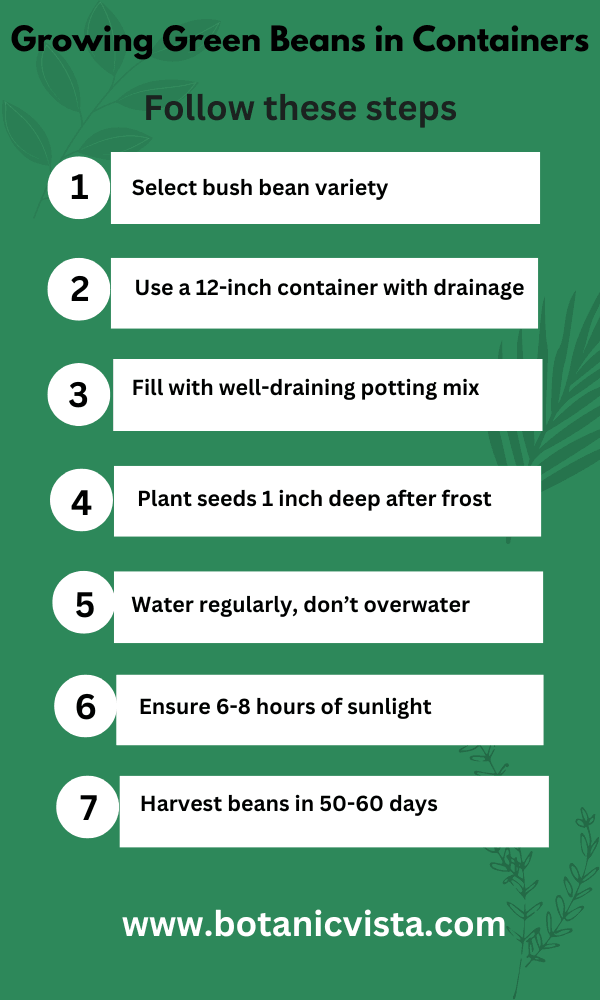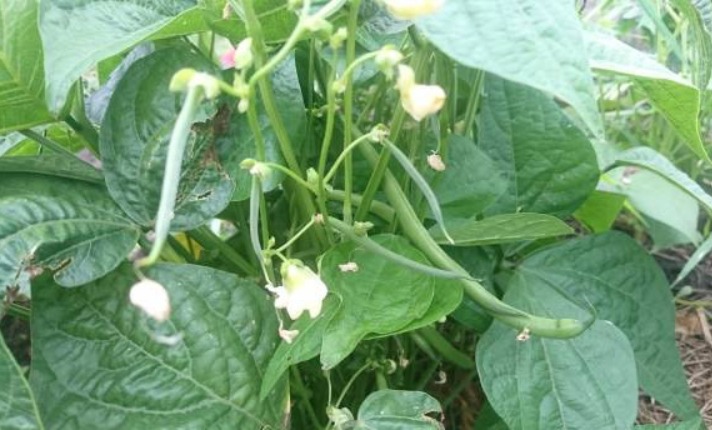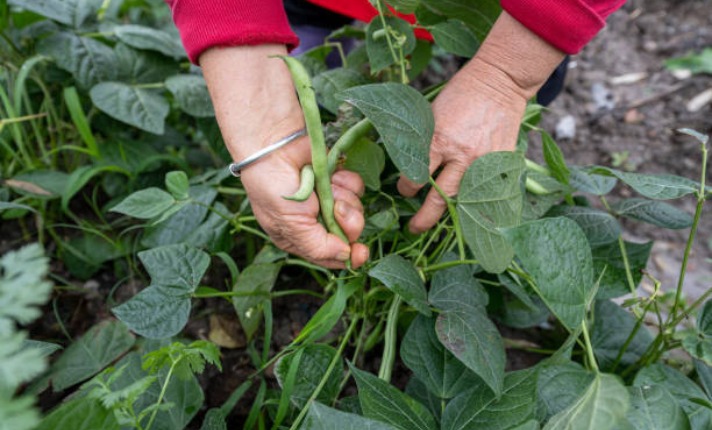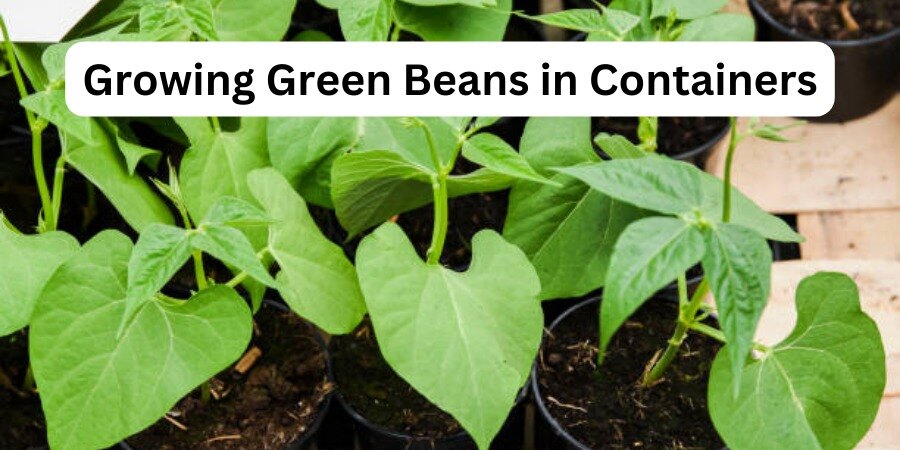Last Updated on October 10, 2024 by Jocelyn
Growing green beans in containers is a smart choice, especially if you don’t have a big garden. Using planters or raised garden beds on your sunny back deck or patio is perfect for beginners and even kids.
Various types of the common bean, Phaseolus vulgaris, produce these young, unripe fruits. There are different varieties of green beans, such as bush and pole types. Both types can grow well in containers.
Opt for modern, stringless varieties for easier harvesting. Planting green beans in containers allows for mobility and additional protection.
Choose proper containers, fill them with good soil, plant the seeds, water regularly, and place them in a sunny spot. You’ll soon enjoy a tasty and delicious crop of green beans.

Table of Contents
ToggleChoosing the Right Green Bean Variety
Choosing the right green bean variety can make a big difference in your garden’s yield and taste. Consider factors like your climate, soil type, and available growing space. Additionally, think about your personal preferences for flavor and texture. By selecting the most suitable variety, you can ensure a bountiful and delicious harvest.

- Bush Beans vs. Pole Beans
Bush beans are compact and good for container gardening. They are self-standing and simpler to manage. Pole beans grow tall and need staking or trellising but use vertical space effectively. Bush beans produce beans in about 50-60 days, while pole beans take around 60-70 days.
- Varieties Suitable for Containers
Some varieties are perfect for containers. Bush beans like Provider and Contender are compact and high-yielding, producing up to 1.5 pounds of beans per plant. Pole beans like Kentucky Wonder and Trionfo Violetto provide a heavy crop and have unique colors.
- Climate Considerations
The local climate impacts what varieties to grow. Heat-tolerant beans like Blue Lake are good for warmer areas, producing beans even in temperatures over 85°F. For cooler climates, Dwarf French beans work well, grow in temperatures as low as 60°F. Kentucky Wonder is versatile and suitable for most climates.
- Heirloom vs. Hybrid Varieties
Heirloom varieties, such as Kentucky Wonder from the 1800s, offer classic flavors and are disease-resistant. They are true to type. Hybrid beans, like Maxibel, provide higher yields and uniformity. Heirloom beans can produce up to 1 pound per plant, while hybrid varieties can yield 1.5 pounds per plant.
- Productivity and Taste Preferences
Choose varieties based on productivity and taste. Tavera Filet offers unique tenderness and is great for the dinner table. Fortex has slender green pods and an excellent flavor. Scarlet Runner is not only productive, with vines growing up to 8 feet, but also ornamental with its bright red flowers.
Selecting the Best Container
Choosing the right container for growing green beans is crucial for their growth and health. The container must have enough space for the roots to expand and support the plants effectively.
Size Matters
A container with a depth of at least 12 inches is essential for healthy root growth and plant support. Compact varieties need less space but still require enough room for robust growth.
Material Choices
Plastic containers are lightweight and easy to move, while terracotta offers a rustic look and keeps the soil cool. Each material has its own advantages, so choose based on your needs.
Proper Drainage
Ensure the container has adequate drainage holes to keep the roots healthy. Adding gravel at the bottom can help improve drainage.
Shape and Color
The color and shape of the container can influence plant growth. Dark-colored containers retain more heat, which can be beneficial in cooler climates. Rectangular or square shapes can optimize space usage and fit better in some areas.
Finding the Perfect Location
Green bean plants need the right sunlight to grow well. Morning light is best because it helps the beans without too much heat. Afternoon sun can be too hot and scorch the leaves.
Partial shade can protect the foliage. Find a spot with direct sunlight for at least 6 hours. This helps the bush beans and pole beans to grow plump and tender.
In warmer weather, sun is important. Too much can be harsh, so use protection like shade cloth. This keeps the plants healthy and green.
Indoor planting can work, but outdoor spaces are better. Sunny spots help the green growth and flowers to bloom. If it’s windy, place the container where it has some protection.
Bush varieties and pole beans both need light and a sunnier spot. Warm-weather beans give a good yield when planted in the right place. This leads to an abundance of beans to harvest.
Preparing the Perfect Potting Mix
Green beans in containers need a perfect potting mix. Here’s how to make it.

- Ideal Soil Composition
A nutrient-rich environment is crucial for healthy roots and plentiful pods. The best potting mix is loamy and drains freely. Avoid garden soil as it compacts and can be detrimental.
- Importance of Nutrient-Rich Environments
Green beans are heavy feeders. Incorporate manure, compost, and a slow-release fertilizer for a steady supply of nutrients. Bone meal promotes strong root growth, especially in the initial growth phase.
- pH Balance for Optimal Growth
Test the pH of your soil mix. Green beans prefer a pH of 6-7. Use a testing kit and adjust with lime or sulfur as needed.
- Adding Organic Matter and Extra Perks
Add worm castings for a powerhouse of nutrients. Perlite and vermiculite help the soil drain well and retain moisture. Coconut coir can absorb and release water, perfect for hot climates.
- Refreshing Old Potting Soil
Reuse old potting mix by refreshing it with compost and organic matter. This aerates the soil and keeps it loose.
- Moisture Control Tips
Moisture control is key. Mix in soil polymer to help with consistent watering. Ensure the containers have proper drainage to prevent root rot.
With these tips, you can create the perfect potting mix for beans in containers.
Planting Your Green Bean Seeds
How can you plant green beans in containers successfully? Here’s a guide to help you.
1. Ideal Planting Time
Plant your seeds after the last frost date when the soil temperature has reached 60°F. In warmer climates, like Texas, you can plant earlier.
2. Seed Depth and Spacing
Sow the seeds about an inch deep. For bush varieties, space them 4 inches apart. For pole varieties, plant 4 inches apart around a central support like a trellis.
3. The Initial Watering
Water the seeds gently and thoroughly right after planting. Ensure the potting mix is moist but not soggy to promote germination.
4. Temperature and Light Requirements
Green beans prefer temperatures between 65°-85°F. Place the containers in a sunny location where they can get at least six hours of direct sunlight daily.
5. Supporting Pole Beans
Set up trellises or stakes at the time of planting to avoid damaging the fragile roots later. Train the young plants to climb using wire or string supports.
6. Thinning Seedlings
Once the seedlings emerge and reach a couple of inches tall, thin them out to ensure proper air circulation. Aim for one plant every 3-4 inches for bush beans and 6-8 inches for pole beans.
7. Observing for Germination
Keep a watchful eye on your pots for signs of germination, which typically happens within 8-10 days. Make sure the young shoots receive plenty of sunlight to grow strong.
8. Additional Tips
To maintain consistent moisture, water regularly and check the soil’s dampness. Avoid letting the soil dry out completely. For fall crops, plant in August for a late harvest.
Expand your vegetable container garden with my guides:
Caring for Your Bean Plants
With just a few easy steps, you’ll be picking fresh beans right from your porch! Regular care is key to healthy plants and a good harvest. Here’s how to care for your bean plants:
| Caring Tips | Details |
| Regular Watering | Water 2-3 times per week. Keep soil moist but not waterlogged to avoid root rot and fungus. |
| Soil and Fertilizer | Use well-drained soil. Beans rarely require fertilizing due to nitrogen fixation. If needed, use a 5-10-10 formula. |
| Sunlight and Support | Ensure 6-8 hours of full sun. Use stakes or trellises for support. |
| Harvesting | Check daily for flowers and bean pods. Harvest frequently to encourage growth. |
| Mulching | Apply organic mulch like straw to retain moisture, regulate soil temperature, and suppress weeds. |
| Pruning | Remove dead or damaged foliage to prevent disease and pests. |
Boost your garden with my vegetable-growing tips:
Pest Management
Check your plants often for pests. Look at the leaves and stems for damage. Small insects like aphids and mites can be culprits. They suck the juices from the leaves.
Use insecticidal soap to treat aphids and spider mites. Mix a few drops of dish soap with water and spray on the leaves. Neem oil is another good treatment. It works on many insects. Just be careful not to spray it on flowers when pollinators are around.
Bean leaf beetles can defoliate the plants. They eat the tissues of the leaves, which can be fatal to your plants. Ladybugs can help control these pests. They eat the aphids and other small insects.
For a natural approach, use diatomaceous earth. Sprinkle it on the soil to keep insects away. Chemical-free methods like this are safe for your plants and the environment.
Regular inspections help spot infestation early. Look for tiny whiteflies, thrips, and leafhoppers. These pests can spread diseases. Neem oil and pyrethrin from the pyrethrin daisy are good treatments.
If you see fungal infections, it means the leaves are too wet. Oils and dish detergents can prevent this. Keep your plants dry, especially the leaf surfaces.
Use fabrics to cover your plants and protect them from insects and small mammals. This will also keep your beans safe until it’s time to harvest. Always follow a good schedule for planting and crop care to avoid pests.
Harvesting Beans
When flowers appear, it means the self-compatible and self-pollinating plants will soon set fruit. Sometimes, you might need a bit of manual intervention to help the fruit to set.
Start succession planting with seedlings for continuous growth. Use determinate bush beans and give each plant enough space.
Harvest in the morning when beans are crisp and full of moisture. Use scissors or your fingers to pinch off the beans. Store them in the refrigerator right away.
Succession planting ensures you have young, tender beans all season. Pick beans when they are plump and firm but without bulges. Enjoy them in recipes or for snacking.
If flowering plants need deadheading, do it gently. Different varieties of beans might mature at different times, so keep an eye on them from midsummer to early autumn.
Always wash your beans before eating. Whether you like them fresh, frozen, canned, or pickled, freshly harvested beans taste the best.
Enjoy your garden and the delicious beans you grow!

FAQ’s
Q: How Many Green Beans Can You Plant in a 5 Gallon Bucket?
A: To grow beans in a 5-gallon bucket, you can plant 2-3 pole bean plants. Bush beans are also a great choice. This size bucket is perfect for a bumper harvest of tasty beans.
Q: What Size Grow Bag Do I Need for Green Beans?
A: For green beans, use a 5-gallon fabric bag. Plant 5-6 seeds per bag to give the plants enough space. This setup is excellent for growing fresh vegetables at home.
Q: How Often Do You Water Vegetables in a Grow Bag?
A: To grow lettuce, fill the pot with soil and plant the seeds. Make sure the soil stays moist. Water the lettuce daily, especially during hot months. If the soil dries out, the lettuce won’t grow well. Check the roots to ensure they’re healthy.
Q: What Month Do You Plant Beans?
A: You can plant beans from April through August. In March, you can start planting pole beans. Bush beans are best planted through July and August. For snap beans, September is a good time.
Q: Do Green Beans Need a Trellis?
A: Bush beans grow compactly and do not require a trellis. Pole beans, however, reach about 10 feet and need support like staking or a structure. Climbing vines may need extra support.
Conclusion
Want to know the secrets to growing green beans in containers? Start by choosing large containers with drainage holes. This helps your green beans grow well. Fill the pots with high-quality soil.
Find a sunny spot for your containers because green beans love sunlight. Make sure to water them regularly, but avoid letting the soil get too wet.
Add stakes to support the plants as they grow taller. This will keep them upright and healthy. Use a balanced fertilizer to provide the nutrients they need.
Keep the soil moist but not soggy, support your plants, and harvest the beans when they are young. Enjoy the process and your fresh green beans!

